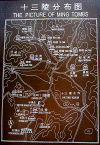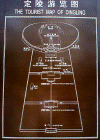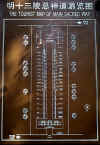Home
Glenayre
The Office
Training Rooms
The Sites
The
Great Wall
The Ming Tombs
The Summer Palace
The Forbidden City
Tianamen Square
Miscellaneous
Wheat Drying
Silk Street
Hotel
Street Scenes
Other Shopping
Other Fun Stuff
|
|
At a distance of 50 km northwest of Beijing stands an
arc-shaped cluster of hills fronted by a small plain. Here is where 13 emperors of the
Ming dynasty (1368-1644) were buried, and the area is known as the Ming Tombs.
Construction of the tombs started in 1409 and ended with the fall of the Ming Dynasty in
1644. In over 200 years tombs were built over an area of 40 square kilometers, which is
surrounded by walls totaling 40 kilometers. Each tomb is located at the foot of a separate
hill and is linked with the other tombs by a road called the Sacred Way.
Only the Tomb of DingLing has been excavated and been made open to the public.
The DingLing Tomb is located in an excavated area with 10 flights of stairs leading down
to the tombs. (This after climbing the Great Wall.) |

Map of the Area
|

DingLing Tomb Map
|
This picture is of a map depicting the area of DingLing.
Notice the center line of the area. The Chinese must always have this central line
in their lives and in their death. This line continues all the way to the end of the
tombs. |
The Sacred Way inside the gate of the Ming Tomb is lined
with 18 pairs of stone human figures and animals. These include four each of three types
of officials: civil, military and meritorious officials, symbolizing those who assist the
emperor in the administration of the state, plus four each of six types of animals: lion,
griffin, camel, elephant, unicorn and horse. |

|

Picture of a
Meritorious Official
|

|
|
Of course, I had to pretend that
I was one of the Generals.
|
|
